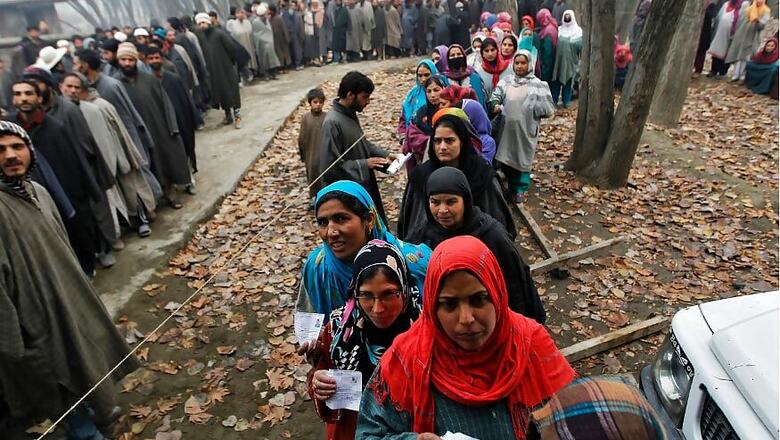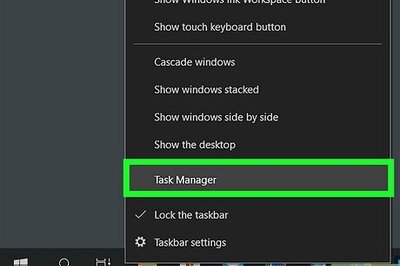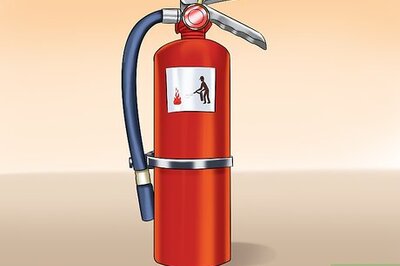
views
Going by the exit polls, of the six Lok Sabha seats in Jammu and Kashmir, the BJP is predicted to win two in Jammu, the Congress one in Ladakh and the National Conference (NC) all the three seats in the Valley.
The Times Now-VMR has predicted the BJP will win two seats in the northern-most state of India, while the Congress and the NC are predicted to get four seats in Lakadh and the Valley.
The exit poll has predicted a massive difference in the voting share between the two former allies — the Bharatiya Janata Party (BJP) at 30.6% and Mehbooba Mufti-led Peoples Democratic Party (PDP) at 10%.
According to the News Nation exit poll, the BJP is likely to bag 33% vote share and the Congress may secure 28% vote share. Regional parties, NC and PDP, are expected to fetch a vote share of 14% and 11%, respectively.
On the other hand, Jan Ki Baat has predicted one-two seats for the BJP in the state, while as the NC-Congress is projected to win three-four seats and the PDP is set to win one seat.
Most of the exit polls have also predicted that the Mufti-led party is likely to lose from all three seats of Kashmir.
The NC and PDP didn’t contest from Jammu fearing division of secular votes that would benefit the BJP. With exit polls showing the BJP winning both the Jammu seats, it looks like the strategy to consolidate the secular vote hasn’t worked in the region.
This was the first general election being held in what has come to be known as the post-Burhan Wani phase. Two months before voting, the Pulwama terror attack in which 40 CRPF jawans were killed further complicated the situation.
In the three seats of the Valley, elections were held in five phases. The Anantnag constituency, which consists of four south Kashmir districts of Kulgam, Pulwama, Shopian and Anantnag, voted in three phases, a first in the electoral history of the country, owing to security concerns.
Marred by violence and calls for boycott from separatists, Jammu and Kashmir recorded an overall voter turnout of a mere 43.5% in the ongoing Lok Sabha elections, its lowest since the 2004 polls.
Despite a multi-phased polling schedule, a low turnout can be a cause of worry for authorities as it indicates a sense of disenchantment with the electoral process among people.
The low turnout came in the wake of a worsening security situation in the Valley and a rise in violence. Security forces have also cracked down on militants after 40 CRPF jawans were killed in the February 14 terror attack in Pulwama, which was claimed by the Pakistan-based Jaish-e-Mohammed.
While militancy and security played a part, residents of the Valley’s three parliamentary constituencies of Anantnag, Baramulla and Srinagar also showed little enthusiasm for the electoral process. These three seats cumulatively registered a voter turnout of just 19%.
The individual turnout was the worst in Anantnag, where 8.79% of voters came out to exercise their franchise, followed by Srinagar at 14%. At 34%, Baramulla saw a relatively better turnout.
According to data compiled by the Jammu & Kashmir Coalition of Civil Society (JKCCS), a human-rights organisation working in the state, incidents of violence have seen a consistent rise since a low in 2012, with 2018 being the bloodiest year in a decade.
Last year’s violence resulted in the death of 159 security personnel and 160 civilians. As many as 267 militants were also killed in encounters with the security forces during the year. Of the 160 civilians killed in 2018, 123 deaths were reported from the districts of Kulgam, Anantnag, Pulwama, Shopian, Srinagar, Ganderbal, Budgam, Baramulla, Bandipora, and Kupwara — all these districts come under the Lok Sabha constituencies of Anantnag, Baramulla, and Srinagar.
At least 57 killings have taken place in the state as of May 4, according to data from the South Asia Terrorism Portal (SATP), a Delhi-based think-tank on conflict zones. In these 57 incidents, 14 civilians and 59 security personnel lost their lives while 75 militants were killed over the same period. These figures include the fatalities in the Pulwama attack.
The Valley, embroiled in violence for over three decades, has historically seen low voter turnouts. Over the last five general elections from 1998 to 2014, the turnout in Anantnag has remained below 30%. In 1999 and 2004, it was below 15%.
Srinagar and Baramulla have followed the same trend, with the latter’s turnout a little north of the 30% mark.
The Anantnag Lok Sabha seat has been vacant since June 2016 after Peoples Democratic Party’s Mehbooba Mufti was sworn in as the chief minister. The Election Commission had failed to hold bypolls in the constituency on three occasions — in April, May and November in 2017 — stating that the “situation was not conducive” for the exercise. Consequently, Anantnag became the longest delayed bypoll in the country.
During the current elections, while it took five phases to conduct the exercise for all six seats in the militancy-hit northern parts of the state, voting for Anantnag was spread across an unprecedented three phases due to security concerns.
In Srinagar bypolls in 2017, the turnout was a mere 7%. The polling day had witnessed widespread protests, leading to the deaths of eight people. When re-polling in 38 booths was held four days later, only 2% had turned up to vote.
Eventually, National Conference patron Farooq Abdullah won the seat, with a mere 3.84% of the total electorate voting for him. But in technical terms, Abdullah garnered nearly 55% of the total valid votes cast in the bypoll.




















Comments
0 comment